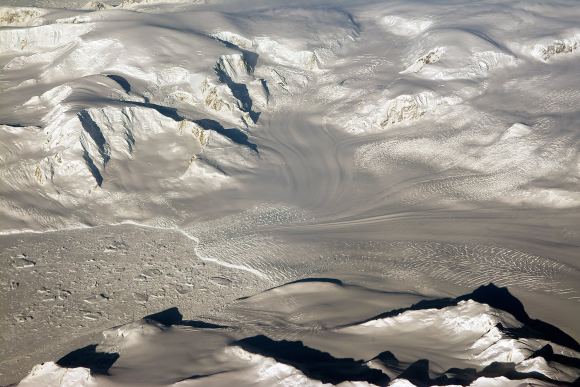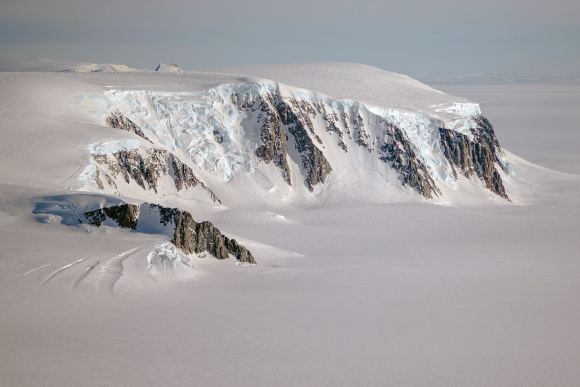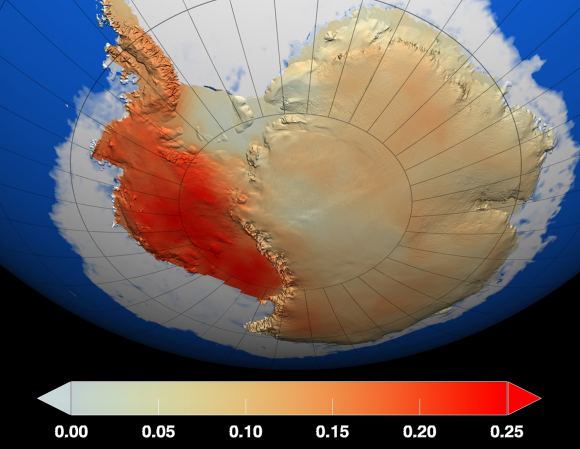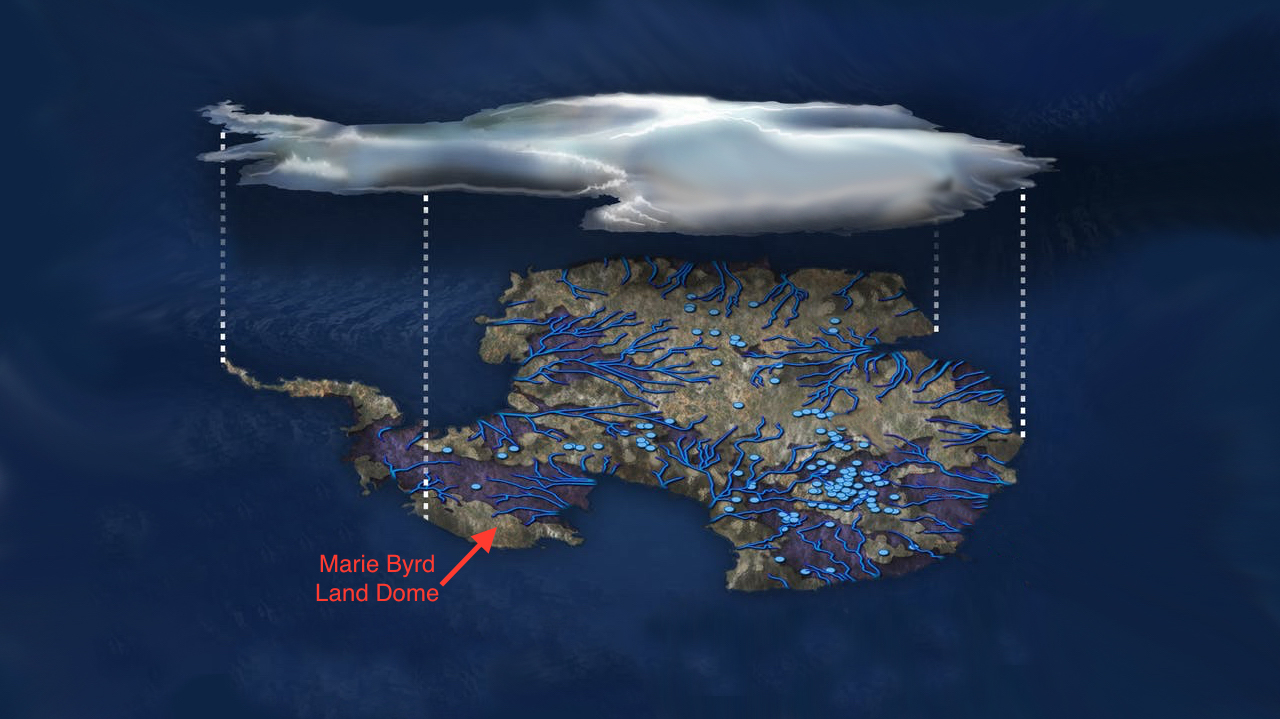Beneath the Antarctic ice sheet, there lies a continent that is covered by rivers and lakes, the largest of which is the size of Lake Erie. Over the course of a regular year, the ice sheet melts and refreezes, causing the lakes and rivers to periodically fill and drain rapidly from the melt water. This process makes it easier for Antarctica’s frozen surface to slide around, and to rise and fall in some places by as much as 6 meters (20 feet).
According to a new study led by researchers from NASA’s Jet Propulsion Laboratory, there may be a mantle plume beneath the area known as Marie Byrd Land. The presence of this geothermal heat source could explain some of the melting that takes place beneath the sheet and why it is unstable today. It could also help explain how the sheet collapsed rapidly in the past during previous periods of climate change.
The study, titled “Influence of a West Antarctic mantle plume on ice sheet basal conditions“, recently appeared in the Journal of Geophysical Research: Solid Earth. The research team was led by Helene Seroussi of the Jet Propulsion Laboratory, with support from researchers from the Department of Earth and Planetary Sciences at Washington University and the Alfred Wegener Institute, Helmholtz Center for Polar and Marine Research in Germany.

The motion of Antarctica’s ice sheet over time has always been a source of interest to Earth scientists. By measuring the rate at which the ice sheet rises and falls, scientists are able to estimate where and how much water is melting at the base. It is because of these measurements that scientists first began to speculate about the presence of heat sources beneath Antarctica’s frozen surface.
The proposal that a mantle plume exists under Marie Byrd Land was first made 30 years ago by Wesley E. LeMasurier, a scientist from the University of Colorado Denver. According to the research he conducted, this constituted a possible explanation for regional volcanic activity and a topographic dome feature. But it was only more recently that seismic imaging surveys offered supporting evidence for this mantle plume.
However, direct measurements of the region beneath Marie Byrd Land is not currently possible. Hence why Seroussi and Erik Ivins of the JPL relied on the Ice Sheet System Model (ISSM) to confirm the existence of the plume. This model is essentially a numerical depiction of the physics of the ice sheet, which was developed by scientists at the JPL and the University of California, Irvine.
To ensure that the model was realistic, Seroussi and her team drew on observations of changes in altitude of the ice sheet made over the course of many years. These were conducted by NASA’s Ice, Clouds, and Land Elevation Satellite (ICESat) and their airborne Operation IceBridge campaign. These missions have been measuring the Antarctic ice sheet for years, which have led tot he creation of very accurate three-dimensional elevation maps.

Seroussi also enhanced the ISSM to include natural sources of heating and heat transport that result in freezing, melting, liquid water, friction, and other processes. This combined data placed powerful constrains on the allowable melt rates in Antarctica, and allowed the team to run dozens of simulations and test a wide range of possible locations for the mantle plume.
What they found was that the heat flux caused by the mantle plume would not exceed more than 150 milliwatts per square meter. By comparison, regions where there is no volcanic activity typically experience a feat flux of between 40 and 60 milliwatts, whereas geothermal hotspots – like the one under Yellowstone National Park – experience an average of about 200 milliwatts per square meter.
Where they conducted simulations that exceeded 150 millwatts per square meter, the melt rate was too high compared to the space-based data. Except in one location, which was an area inland of the Ross Sea, which is known to experience intense flows of water. This region required a heat flow of at least 150 to 180 milliwatts per square meter to align with its observed melt rates.
In this region, seismic imaging has also shown that heating might reach the ice sheet through a rift in the Earth’s mantle. This too is consistent with a mantle plume, which are thought to be narrow streams of hot magma rising through the Earth’s mantle and spreading out under the crust. This viscous magma then balloons under the crust and causes it to bulge upward.

Where ice lies over top of the plume, this process transfers heat into the ice sheet, triggering significant melting and runoff. In the end, Seroussi and her colleagues provide compelling evidence – based on a combination of surface and seismic data – for a surface plume beneath the ice sheet of West Antarctica. They also estimate that this mantle plume formed roughly 50 to 110 million years ago, long before the West Antarctic ice sheet came into existence.
Roughly 11,000 years ago, when the last ice age ended, the ice sheet experienced a period of rapid, sustained ice loss. As global weather patterns and rising sea levels began to change, warm water was pushed closer to the ice sheet. Seroussi and Irvins study suggests that the mantle plume could be facilitating this kind of rapid loss today, much as it did during the last onset of an inter-glacial period.
Understanding the sources of ice sheet loss under West Antarctica is important as far as estimating the rate at which ice may be lost there, which is essentially to predicting the effects of climate change. Given that Earth is once again going through global temperature changes – this time, due to human activity – it is essential to creating accurate climate models that will let us know how rapidly polar ice will melt and sea levels will rise.
It also informs our understanding of how our planet’s history and climate shifts are linked, and what effect these had on its geological evolution.
Further Reading: NASA, Journal of Geophysical Research


“Given that Earth is once again going through global temperature changes – this time, due to human activity – it is essential to creating accurate climate models that will let us know how rapidly polar ice will melt and sea levels will rise.”
Matt, your essay was well written and undoubtedly factual until you dropped the need to continue in that vein in favor of inserting personal opinion. Even the most naive surely realize that Earth has, and will continue to have, global temperature changes that are related to the most natural of forces both on the planet and well beyond. The fact that humans live on Earth and are consuming energy in many ways is a factor, the size and scope of these effects remaining immeasurable while conjecture and speculation speak to the absence of scientific fact.
If you have a non-anthropogenic explanation for the rise in CO2 levels since the industrial revolution, I’d be open minded to hearing it.
https://www.esrl.noaa.gov/gmd/ccgg/trends/history.html
It’s not an essay, sir. It’s an article. And that is NOT personal opinion, it’s a scientific fact. Anyone who rejects this consensus and all the research, which supports that conclusion, in favor of believing that the current trend is natural or just a theory is being naive.
This is some unwelcome news for the stability of the west Antarctic ice sheet. Based on current rates of melting, global Co2 levels, and global mean average temperatures, it is likely the western ice sheet will be history by the middle of this century. It is currently being undermined by warm water and is in the process of rapid decline of its surface area. It is too bad, the western sheet would likely be bigger and less far along in melting if it were not for this mantle plume pushing the seafloor up while at the same time warming it. The stability of the colossal east Antarctic ice sheet is of course more important and this finding may help explain why this has remained relatively stable so far. However with the loss of the ice shelves, glacier outflow will increase dramatically depleting this in the long run as well.
“the mantle plume could be facilitating this kind of rapid loss today, much as it did during the last onset of an intergalactic period”
Interglacial perhaps, unless I missed some big news
Oh dear, thanks for the heads-up. Man, I hate autocorrect!
;o)